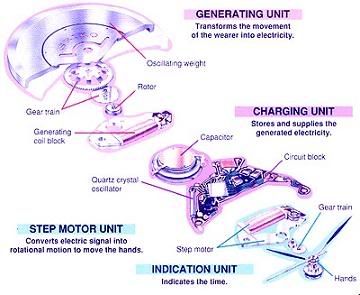Batteries not included - behind the Seiko Kinetic
I own two Seiko Kinetic watches, one of them about five years old, the other about seven. They have been reliable for the most part, but in an unusual turn of events, they have both been brought in for service twice in the last twelve months.
Kinetic watches are different from other watches in the sense that they are powered by the wearer's natural wrist movements instead of depending on a compressed mainspring (as with automatic/self-winding watches) or a battery (as with conventional quartz watches). The Kinetic mechanism taps into these motions, converting them into electrical energy by means of a small generator, and storing this energy into a set of four micro-capacitors (referred to by Seiko as an Electrical Storage Unit or ESU) which powers the movement of the watch. Seiko first marketed this technology in 1988, and started using the Kinetic name in 1992.

How the Seiko Kinetic works.
This approach combines the accuracy of quartz movements (+/- 15 seconds a month) with the capability of automatic watches to generate their own power. Worn regularly, Kinetic watches will run indefinitely, and won't ever require a battery change.
Well, that's the claim at least. Both of my Kinetic watches were brought in for service for basically the same problem, the inability to hold a charge for long, resulting in the movement stopping. It was a gradual decline, at the onset the movement would stop if the watch wasn't worn and just left laying on the dresser. After a while the movement would stop even if you were wearing the watch.
Both of my Kinetic watches were brought in for service for basically the same problem, the inability to hold a charge for long, resulting in the movement stopping. It was a gradual decline, at the onset the movement would stop if the watch wasn't worn and just left laying on the dresser. After a while the movement would stop even if you were wearing the watch.
Upon diagnosis at the service center, it turns out the capacitor sets (ESUs) of both watches had to be replaced. Both watches were repaired without any other significant issues, and they seemed to be working perfectly again. Unfortunately, after nine months both watches quit again, with the same problems of being unable to hold a charge. The cause in both watches was determined to be something in the assemblies which hindered the rotation of the main rotor in the Kinetic mechanism, preventing it from thoroughly charging the ESU. Both watches were repaired the second time free of charge, owing to the problem created when both watches were first serviced.
The cause in both watches was determined to be something in the assemblies which hindered the rotation of the main rotor in the Kinetic mechanism, preventing it from thoroughly charging the ESU. Both watches were repaired the second time free of charge, owing to the problem created when both watches were first serviced.
While I'm still a fan of Seiko watches, in particular those models which utilize Kinetic technology, I have come to the realization after more than five years that they are not as reliable or as foolproof as they are marketed to be. Don't get me wrong, Seiko watches in general are of high quality and built within exacting specifications. In fact, these watches are probably more reliable than most other brands, even more expensive ones.
However, they aren't perfect.
When I bought my first Kinetic watch in 1998, I had expected it to be a maintenance free watch. Well, that's what the ads said. No battery changes, highly accurate, no need for servicing. While it has lived up to most of my expectations as far as its accuracy is and everyday reliability is concerned, it is, simply put, still a mechanical device that needs service from time to time. It may not need regular battery changes, but the ESUs would probably need replacing at certain intervals (measured in years). It seems that Seiko itself has discovered the problems with the capacitors in its ESUs, and in 2000 replaced one of them with a Lithium Ion cell (in effect a secondary battery) to improve the watch's overall ability to store energy.
Still, Kinetic watches are impressive for the technology they contain. Seiko has continued to further refine the technology, coming up with more efficient calibres (watch movements) boasting better charge retention capabilities. They have also come up with a variant known as Kinetic Auto Relay which features advanced power management capabilities allowing it to retain the correct time for as long as four years, even when the watch becomes dormant.
Seiko has always been a force to reckon with when it comes to advancing the state-of-the art as far as watch design is concerned. Seiko watches utilizing the Kinetic technology are no exception. I guess nothing less can be expected from the company which invented the quartz watch.
Just don't expect them to be perfect.
Now if I could only afford a TAG Heuer. :-)
Trivia:
The very first quartz watch is the Seiko Astron, introduced in 1969.
The science of timekeeping, clocks and watches is known as Horology.
Comments